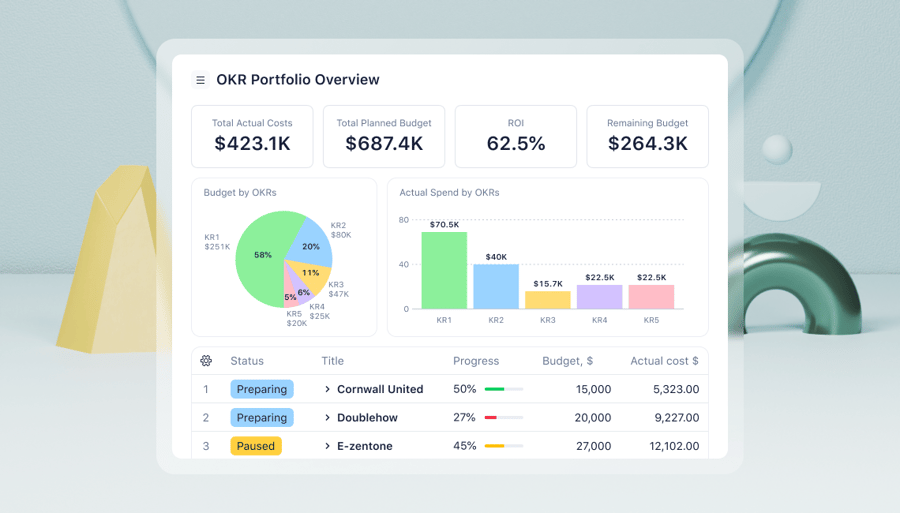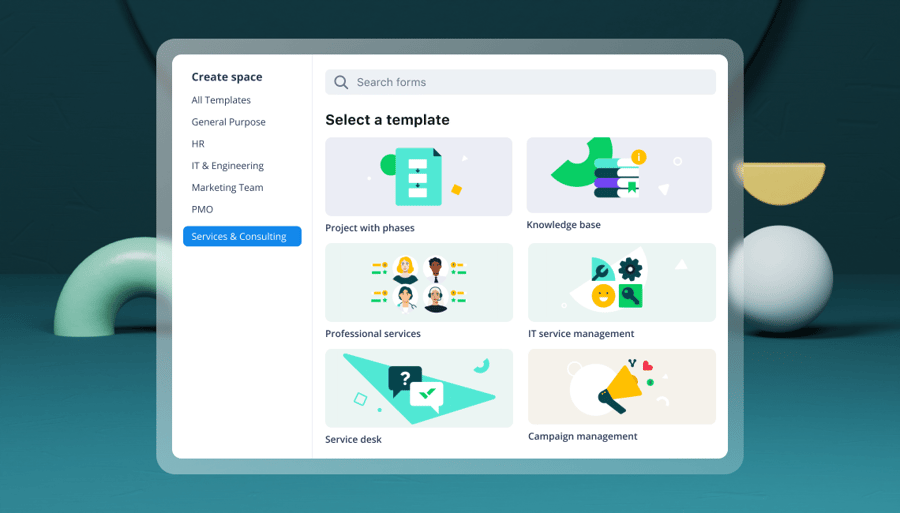Key takeaways:
- What is the critical path method (CPM)? CPM is a project management technique for identifying key tasks that affect project duration and ensuring timely completion within budget.
- How does CPM benefit project management? It visualizes project timelines, prioritizes critical tasks, aids in risk mitigation, and improves team communication.
- What steps are involved in calculating the critical path? Identify tasks, determine their sequence, estimate durations, draw a network diagram, identify the critical path, calculate float, and monitor progress.
- How does CPM differ from PERT? CPM focuses on fixed task durations for predictable projects, while PERT accommodates uncertainty by estimating multiple task durations.
- How can Wrike enhance CPM implementation? Wrike automates critical path determination, offers project scheduling templates, and provides Gantt charts for effective visual management.
Back in the 1950s, project delays were a serious problem, and there wasn’t much structure around how to avoid them. That’s when engineers at DuPont and Remington Rand teamed up to solve a growing challenge: how to schedule complex projects with more confidence and less guesswork.
The result was the critical path method (CPM), developed by Morgan R. Walker and James E. Kelley, and it changed project management forever.
CPM introduced a smarter way to work. Instead of just listing tasks, teams could now map out the entire flow of a project, identify which steps were essential, and spot potential bottlenecks before they caused delays. It was like giving teams X-ray vision into their timelines.
Fast forward to today, and CPM is still a go-to strategy for delivering high-stakes projects on time, whether you’re managing a product launch, a construction site, or an enterprise rollout.
The critical path method does two main things:
- It helps project managers identify the most important tasks that critically affect the project’s duration.
- It helps project managers make an efficient schedule so they can finish the entire project on time and within budget.
In this article, we’ll tell you everything you need to know about the critical path method, and answer questions such as:
- What is the critical path in project management?
- What are the steps for using CPM for project management?
- How do you calculate the length of your project?
- How do you maintain a project schedule that provides flexibility within your critical path?
What is the critical path method?
The critical path method (CPM) is a sophisticated project management technique for planning, scheduling, and managing the tasks necessary to complete a project from start to finish. It is also sometimes referred to as critical path analysis (CPA).
Any team in any industry can use the critical path methodology to manage complex projects.
What’s more, a good project management software platform will be able to take a project’s CPM data and turn it into a visual representation, displaying the tasks, their dependencies, and the critical path to make it easy to understand and manage the project at a glance.
In the CPM, tasks are categorized as critical and non-critical.
- Critical tasks must be completed on time to ensure the project is finished on schedule. Any delay in a critical task will result in a delay in the project.
- Non-critical tasks, on the other hand, have some flexibility in their scheduling, so they’re less likely to cause a delay in project completion.
The CPM is especially valuable for projects with numerous interdependent activities, as it allows project managers to see potential bottlenecks and where resources can be allocated most effectively.
For example, imagine you’re launching a new product. Tasks like finalizing design, building the prototype, testing, and launching may all be linked. CPA helps you determine which exact chain of tasks must stay on schedule, and which ones have wiggle room.
By identifying the critical path, project managers can prioritize tasks, mitigate risks, and better ensure a project’s progress and completion on time.
Why use critical path analysis (CPA)?
CPA (or CPM) helps identify the tasks that directly impact a project’s finish date, so teams can focus on what truly drives delivery.
It helps:
- Improve scheduling accuracy
- Highlight potential delays before they happen
- Ensure teams focus on the most time-sensitive work
Although a project may contain multiple task sequences, there can only be one critical path. Because the project cannot be considered complete or successful until every critical task has been executed, the critical path sets the schedule for the entire project.
Since it plays such a key role in scheduling, critical path analysis is also important for avoiding bottlenecks that can hamstring projects and lead to delayed delivery.
Benefits of using the critical path method in project management
The CPM offers many benefits that can significantly enhance the effectiveness of project management.
- CPM provides a clear visualization of the project timeline. It usually looks like a flowchart. By illustrating the sequence and duration of each task, the CPM allows project managers to gain a comprehensive understanding of the project’s flow, making it easier to plan and manage resources effectively.
- CPM clearly identifies critical tasks. This not only helps in prioritizing tasks but also allows for the proactive management of potential delays. By understanding which jobs have the flexibility to be delayed without affecting the overall timeline, project managers can better manage changes or issues that arise during the project lifecycle.
- CPM aids in risk identification and mitigation. Highlighting the critical path allows project managers to foresee potential bottlenecks or delays and proactively mitigate these risks. This can lead to a significant reduction in project downtime and associated costs.
- CPM promotes better communication within the project team. With a clear visual representation of the project’s timeline, team members can better understand their roles, responsibilities, and the impact of their tasks on the overall project. This can lead to improved collaboration, efficiency, and overall project success.
In summary, CPM is an indispensable tool in project management. It enhances planning, risk mitigation, resource management, and team collaboration.
Limitations of CPM
In the real world, projects aren’t always linear, data isn’t always perfect, and teams juggle more than just task sequences. While CPM is a proven scheduling method, it has key limitations that project managers should keep in mind when planning and executing complex work.
- Relies on accurate data. CPM only works as well as the data it’s built on. If task durations, dependencies, or deadlines are inaccurate, the critical path becomes unreliable — and so do your project forecasts.
- Less flexible for dynamic projects. In fast-moving or Agile environments, CPM can feel too rigid. Every change to the plan requires reworking task sequences, which can slow down teams that need to move quickly.
- May neglect non-critical tasks. CPM focuses attention on critical tasks, but that can lead to neglecting non-critical ones. Even if they don’t affect the timeline directly, delays in these areas can still impact quality or team performance.
- Limited resource management insight. CPM doesn’t account for team capacity. It can sequence tasks perfectly on paper, but if the same person is assigned to multiple critical tasks at once, the schedule falls apart. Without resource visibility, it’s easy to miss overloads and conflicts.
How to find a project’s critical path
Ever wonder which tasks could make or break your project deadline? Finding the critical path shows you exactly where delays matter most. Here’s how to calculate it.
Step 1: Identify all tasks required to complete the project
Start by listing all the functions or activities that need to be completed for the project’s successful conclusion, also known as a work breakdown structure. When created thoroughly, the work breakdown structure is a roadmap that guides a team when completing projects, whether simple or complex.
Here’s a powerful work breakdown structure example from Wrike.
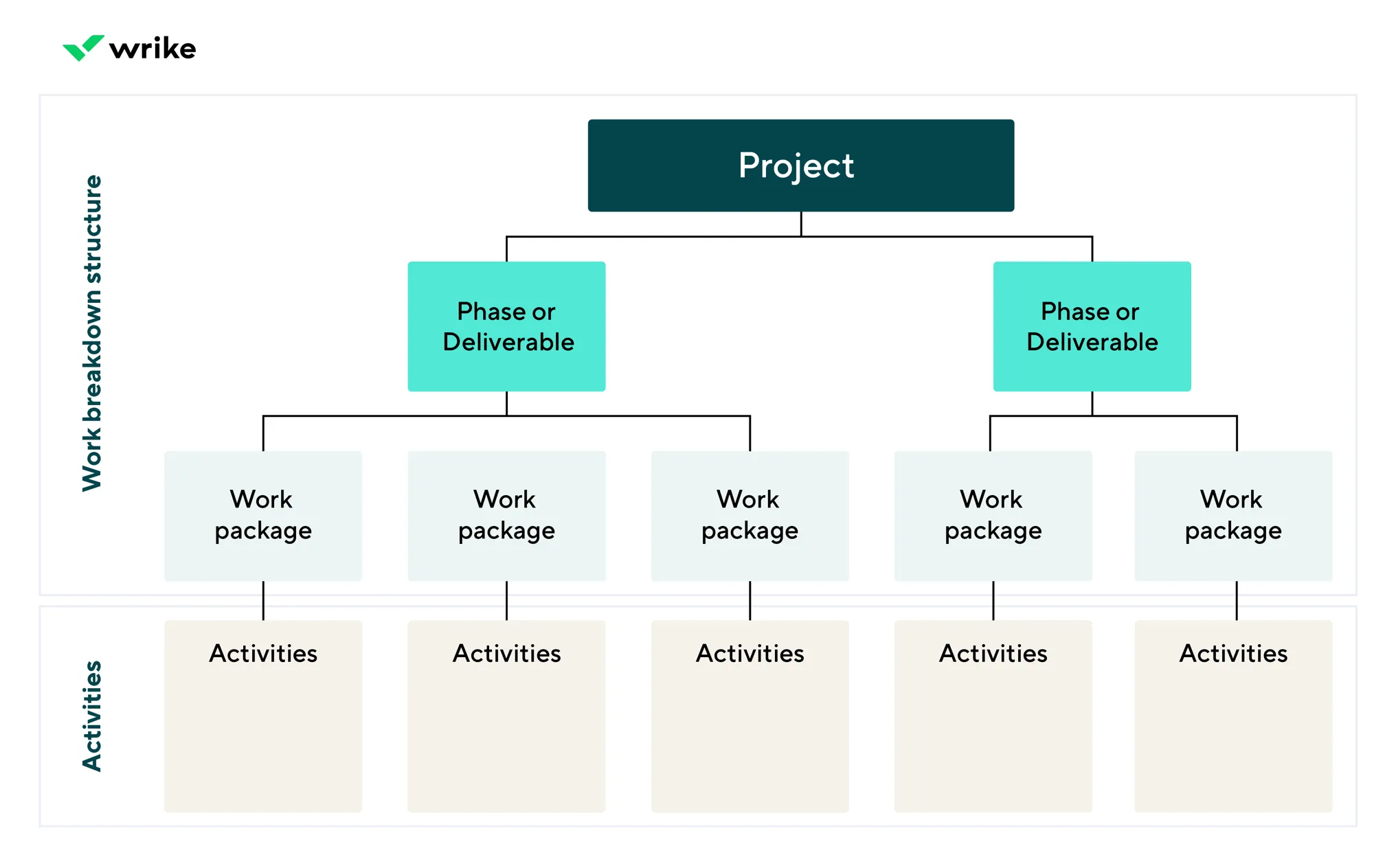
Step 2: Determine the sequence of tasks
Next, identify the order in which the tasks need to be performed. Some tasks may depend on the completion of others before they can begin, while others may be carried out concurrently. This step is crucial in understanding the dependencies and relationships between tasks.
Step 3: Estimate the duration of each task
Assign a time estimate to each task. This should be the total time required to complete each task from start to finish. Make sure to account for any potential delays or issues that may arise by incorporating buffers or contingency time into your estimates.
Two techniques that can help project managers accurately determine each task’s duration are the forward and backward pass techniques:
- Forward pass: Starting from the beginning of the project and moving forward through the critical path diagram, calculate the earliest start time and finish time for each activity. This helps determine the earliest possible project completion date for the entire project.
- Backward pass: Work your way backward from the project’s end date through the CPM chart, calculating the latest start time and finish time for each activity. This helps identify the latest possible project completion date and determines the amount of scheduling flexibility or slack time available for each activity.
Step 4: Draw a network diagram of the critical path
Using the information from the previous steps, draw a network diagram. This visual representation should depict all the tasks, their sequence, and their dependencies. Each task is represented as a node on the diagram, and the arrows between nodes represent the task dependencies.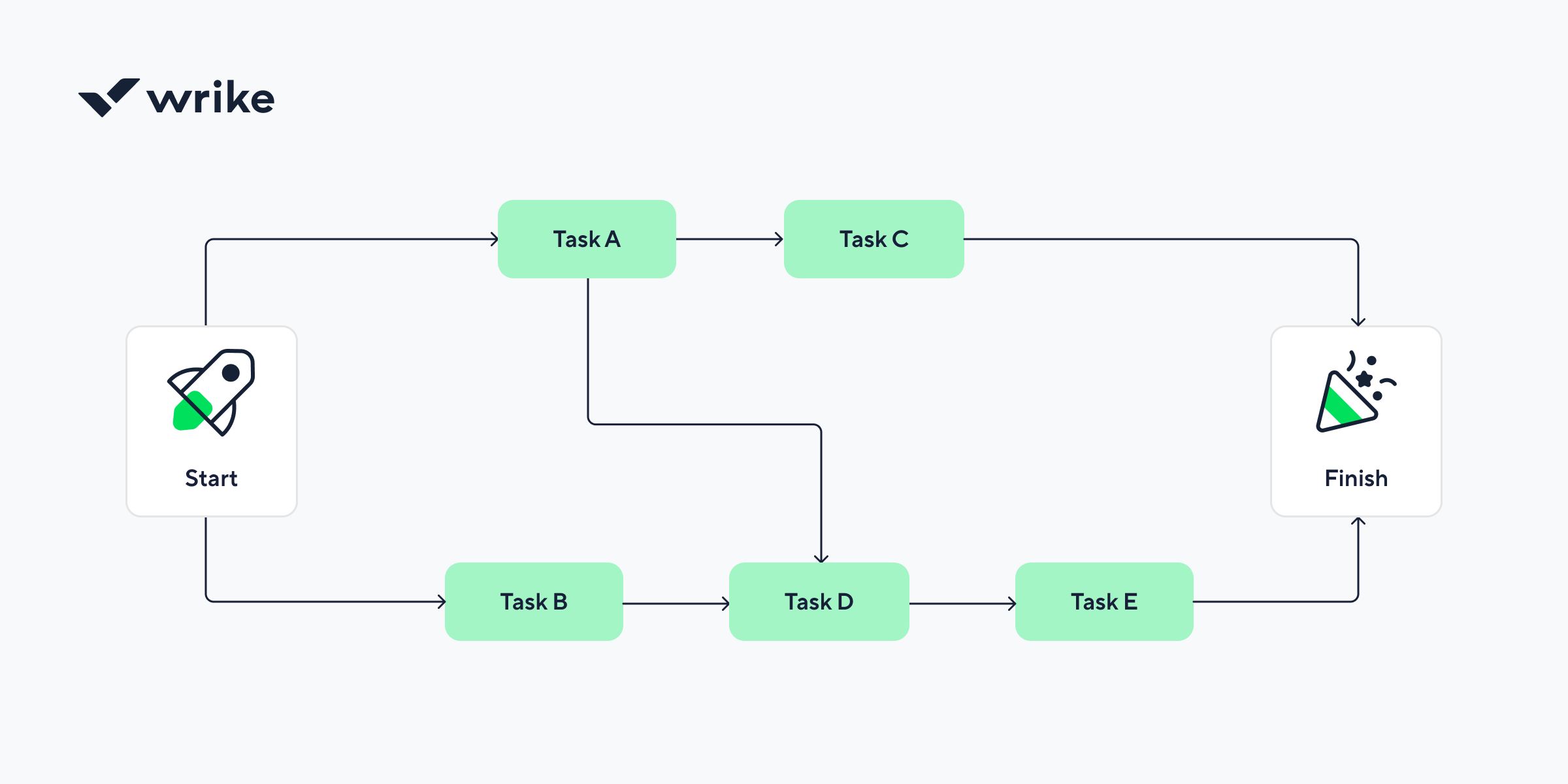
Step 5: Identify the critical path
The critical path is the longest path from the start to the end of the project, passing through all the essential tasks to the project’s completion. In other words, the longest sequence of tasks determines the minimum time needed to complete the project.
This is your critical path, the longest duration from the initial to the final task on your network diagram.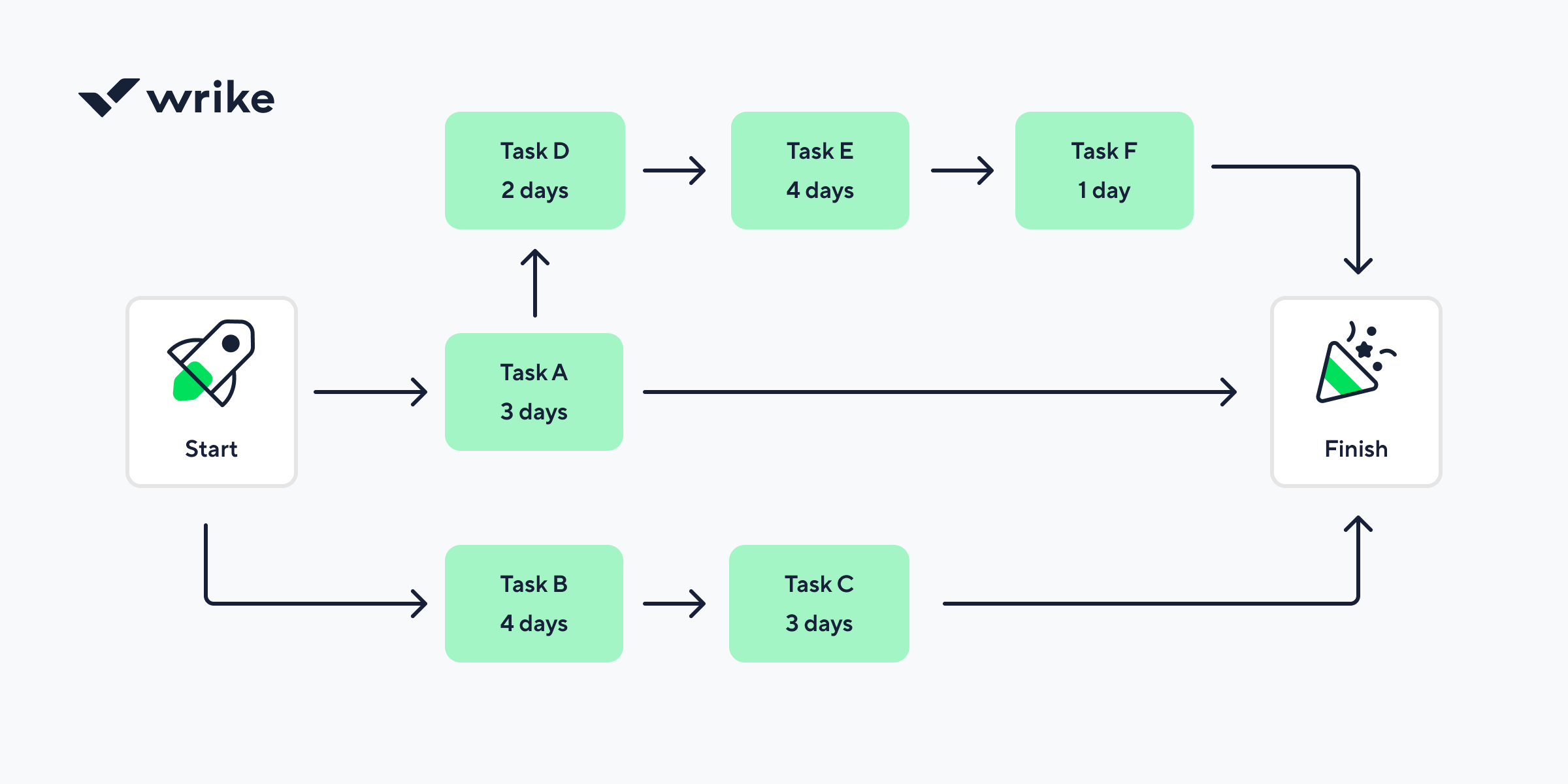
Here are the task dependencies based on the example above:
- Tasks A and B can run in parallel
- Task D is dependent on A
- Task C is dependent on B
- Tasks C and D can run in parallel
- Task E is dependent on D
- Task F is dependent on E
The critical path in the example above is 10 days because tasks A-F will take 10 days to complete. This is the longest duration from first to last task (critical path).
Step 6: Calculate the float
The total float or slack is how long you can delay a task without postponing the project’s completion. Tasks on the critical path will have zero float, meaning they can’t be delayed without impacting the project timeline.
However, non-crucial tasks may have some float, allowing for some flexibility in scheduling.
Free float, which is the amount of time an activity can be delayed without delaying the start of its successor activity, is also included in the overall float calculation.
Step 7: Monitor the critical path
Once the project is underway, closely monitoring the tasks on the critical path is essential. Any delays in these tasks will directly impact the project timeline. Regularly update and review the critical path to help identify potential issues early and keep the project on track.
Consider using Wrike’s project scheduling template to augment this process further. This prestructured template simplifies identifying your project’s critical path, saving time and enhancing your project planning efficiency.
Example of the critical path method in action
Now we’ll demonstrate with a simple, real-life critical path method schedule and example: planning a killer party. How should someone plan and execute this project?
1. Define the project scope
First, we need to define all of the tasks that must be finished to complete the project. For example, if we were throwing a party, it might look like this:
- Choose a date and venue
- Make the ultimate playlist
- Set up the sound system
- Invite your friends
- Buy the food and drinks
- Cook your famous casserole
- Host the party
When we look at these tasks individually, we realize that some of them cannot be started before the others are completed. That is, some tasks are dependent on others. We’ve designated these relationships in the table below:
| Task name | Dependent on |
| Choose a date and venue | - |
| Make the ultimate playlist | - |
| Set up your sound system | - |
| Invite your friends | Choose the date and venue |
| Buy the food and drinks | Invite your friends |
| Cook your famous casserole | Buy the food and drinks |
| Host the party | Casserole and sound system |
The actions “Invite your friends,” “Buy the food and drinks,” “Cook your famous casserole,” and “Host the party” form a sequence of tasks that must be performed in a specific order, one right after the other, to ensure a successful result. Such tasks are called sequential activities.
Together with the start of our project (“Choose a date and venue”), these tasks are the most critical steps in completing our project. Thus, these actions will be placed on the critical path.
2. Define different project paths
You can have multiple critical paths in a project so that several paths run concurrently. This can result from multiple dependencies between tasks or separate sequences that run for the same duration.
Various project paths surface that need to be completed when planning a party. For example, one path could involve tasks related to booking the venue, such as researching options, visiting potential locations, and finalizing the booking.
Another path might focus on the catering, which includes deciding the menu, finding a caterer, and arranging the food and drink delivery. Another path could be about entertainment, involving tasks like hiring a DJ or band and planning games or activities.
While separate, each of these paths is an integral part of the overall project and must be coordinated effectively to ensure a successful party. By clearly defining these different project paths, you can better manage the tasks and timelines associated with each one.
3. Consider the resource constraints
Traditional critical path schedules in project management are based only on causal dependencies. We’ve already marked these dependencies in our plan. (e.g., it’s impossible to cook the casserole without buying the ingredients).
However, a project may have limited resources that need to be considered, such as calculating load in resource planning. These limitations will create more dependencies, often referred to as resource constraints.
If you work on a team, you may split the project work between team members. In our example, while you’re choosing a date and venue and inviting people, one of your friends can make a playlist, and another can get the food and drinks. The tasks can be done in parallel, as in our chart above.
However, if you’re the only person responsible for the project, you have a resource constraint because you can’t be in two places at the same time. In this case, your critical path will look different.
In the table above, we assume you first need to choose the date and venue, and only later can you make a playlist. However, depending on the project conditions, these tasks can be performed in a different order.
4. Calculate the length of your project
Let’s assume you have to do everything by yourself. We estimated the activity duration of each task. Also, we determined the approximate start time for each task on the critical path. Here’s what we came up with:
| Task | Duration | Start |
| Choose a date and venue | 2 hours | Monday |
| Make the ultimate playlist | 3 hours | Monday |
| Set up your sound system | 1 hour | Monday |
| Invite your friends | 2 days | Monday |
| Buy the food and drinks | 1 day | Tuesday |
| Cook your famous casserole | 2 hours | Wednesday |
| Host the party | 2 hours | Wednesday |
Now, if we add up all of our critical tasks’ duration, we’ll get the approximate time we need to complete the whole project. In our case, three days and six hours, since “Make the ultimate playlist” and “Set up the sound system” are not on the critical path.
If we add the duration to the start time, we can calculate the earliest project completion time. Understanding the CPM allows us to make this calculation quickly and accurately.
5. Leave space for flexibility
The critical path method was developed in the late 1950s for complex but fairly predictable projects. However, we rarely manage such projects in real life. Let’s say you plan to redecorate your living room with a friend.
Your task list may look like this:
- Get rid of the old furniture
- Paint the walls
- Fix the ceiling
- Install the new furniture
Your friend’s responsibilities are to:
- Choose the new curtains
- Hang the new curtains
The curtain tasks form a subproject and can be treated as a non-critical path. Your friend can “choose the new curtains” and “hang the new curtains” at any time before the end of your project. The curtain tasks, which have flexibility in the start date and end date, are considered float. These tasks are parallel and will not be placed on the critical path.
Here’s how this project would look on a Gantt chart:

If any of the parallel tasks were to be significantly delayed, it would prevent our whole project from being completed on time. Therefore, you should always keep an eye on parallel tasks.
6. Adjust to changes in the critical path
Let’s assume that choosing the curtains took our friend longer than we initially expected. This will delay the end of the project.
Our redecoration is incomplete without the new curtains, so the path that previously was non-critical becomes critical. The initial critical path changes.
To monitor your non-critical tasks, your project schedule must be current.
That’s the only way you’ll know exactly where your project is at any given moment and whether it will be delivered as initially planned.
7. Compress the schedule (if necessary)
If a project deadline is moved up, you might have to find a way to expedite tasks. While this is not an optimal scenario, there are two ways to accomplish schedule compression within the CPM framework:
- Fast-tracking: This involves overlapping parallel tasks originally planned to be done sequentially in order to shorten the project duration. Fast-tracking can potentially increase project risk due to dependencies between tasks.
- Crashing: This involves the allocation of additional resources (such as manpower or equipment) to critical activities to accelerate their completion. Crashing often results in increased costs, so it’s important to let stakeholders know of any budget changes.
Critical path vs. PERT vs. Gantt charts
CPM, the program evaluation and review technique (PERT), and Gantt charts are valuable project management tools. However, they each have distinct characteristics and are better suited to different types of projects.
| Feature | CPM | PERT | Gantt charts |
| Primary purpose | Identify the longest path of dependent tasks to determine project duration | Estimate project duration under uncertainty | Visually map tasks and timelines |
| Time estimation | Fixed (deterministic) task durations | Three estimates: optimistic, most likely, pessimistic | Task durations shown as fixed bars |
| Best for | Projects with predictable timelines (e.g., construction, manufacturing) | Projects with uncertain task durations (e.g., R&D, innovation) | Any project needing visual task tracking |
| Handles uncertainty | No — assumes durations are known | Yes – built for uncertain or variable timelines | No – does not account for time variability |
| Focus | Critical tasks that determine project’s end date | Probabilistic outcomes and flexibility | Timeline visibility and progress tracking |
| Shows task dependencies | Yes | Yes | Yes, but less detailed |
| Ease of use for terms | Moderate — requires analysis | Moderate — more complex due to multiple estimates | High — easy to interpret and communicate |
| Supports visual progress tracking | Limited | Limited | Yes — intuitive progress view |
CPM is a deterministic approach that assumes a fixed time frame for each task. This makes it ideal for projects with well-known task durations and little variability, like construction or manufacturing projects.
The CPM focuses on the critical path, meaning the sequence of activities or tasks that determines the project’s shortest possible duration. Identifying this path allows project managers to prioritize tasks directly impacting the project’s critical path timeline.
PERT is similar to CPM in that they are both used to visualize the timeline and the work that must be done for a project. However, with PERT, you create three different time estimates for the project:
- The shortest possible amount of time each task will take
- The most probable amount of time
- The most extended amount of time tasks might take if things don’t go as planned
This makes PERT ideal for research and development projects or any other project with uncertain task durations. While both methods help in project planning and scheduling, PERT’s ability to handle uncertainty makes it more flexible in the face of potential changes or delays. The CPM’s focus on the critical path can make managing and controlling tasks critical to the project’s timeline easier.
Gantt charts, on the other hand, are primarily visual tools used to illustrate the project schedule. Rather than analyzing time variability or task dependencies in depth like PERT or CPM, Gantt charts provide a clear timeline that maps tasks across a horizontal time axis.
They make it easy to track progress, understand overlaps, and see who is responsible for what, especially in team settings. When paired with CPM, Gantt charts can help visualize the critical path and make complex schedules more accessible to stakeholders.
The choice between CPM, PERT, or Gantt charts should be based on the nature of your project and the level of certainty or uncertainty in task durations.
Tools and templates
You don’t need to build a critical path diagram from scratch to benefit from CPM. Today’s project management platforms offer built-in tools and templates that make it easy to map dependencies, identify the critical path, and adjust timelines as work evolves.
Look for tools that offer:
- Visual timeline views (like Gantt charts)
- Dependency mapping
- Task duration tracking
- Automated critical path calculation
- Real-time updates across teams
Modern platforms are also incorporating AI to streamline CPM-based planning. For example, some AI project management tools can analyze task data to suggest dependencies, flag bottlenecks, or recommend timeline adjustments based on workload and progress.
If you’re exploring options, here are a few types of solutions to consider:
- Wrike: Offers advanced Gantt charts, dynamic timelines, and built-in critical path visualization. With features like task dependencies, real-time updates, and AI-powered Work Intelligence®, Wrike makes it easy to manage complex workflows with clarity and precision.
- Microsoft Project: A longtime staple in enterprise project management, it provides robust scheduling tools and detailed critical path analysis.
- Smartsheet: Combines spreadsheet-style project tracking with Gantt views and dependency management suitable for CPM planning.
- AI-enhanced planning tools: Emerging platforms now include AI agents with capabilities that support smart scheduling, risk prediction, and task reallocation.
- CPM templates: You can also find downloadable or built-in CPM templates that help teams get started quickly, especially for recurring project types like product launches or cross-functional implementations.
Using the right tools not only makes CPM easier to implement, it also helps teams stay aligned, adapt faster, and deliver with greater confidence.
CPM success stories
This case study provides a practical example of the critical path method in action and illustrates its potential in managing large-scale, complex projects.
The Hoover Dam
The Hoover Dam, constructed between 1931 and 1936, is a testament to the power of effective project management. While the critical path method hadn’t been formally defined yet, the principles of its essential algorithm were applied during the dam’s construction.
The project had many activities, each with dependent tasks and timelines. The project managers had to coordinate these activities to ensure the project was completed on time and within budget. They effectively identified the project’s critical path, focusing resources and attention on the tasks that would cause the most significant delays if not completed on time.
The Hoover Dam was completed two years ahead of schedule despite the project’s complexity. This early completion was primarily due to the effective use of what we now know as the critical path method, making it a compelling case study for successfully implementing this technique.
How Wrike can help you implement the critical path method
Manually determining the critical path of a project isn’t exactly a quick process. That’s why Wrike has a feature that automatically determines your critical path for you. To use this feature, all you have to do is input these essential elements in your schedule on Wrike:
- Start and end dates of all project tasks
- Duration of each task
- Task relationships or dependencies
To further facilitate the process, we’ve also designed a prebuilt template for project scheduling that will help you progress through the steps of building out your critical path.
Our project scheduling template allows our customers to visualize the critical path on a Gantt chart, assign tasks to team members, and drag and drop project activities to ensure proper resource management.
FAQ: Critical path method
What is the formula for the critical path method?
There’s no single formula, but the critical path method uses several calculations, including the forward pass, backward pass, and float. To find the critical path, you need to calculate the earliest start (ES), earliest finish (EF), latest start (LS), latest finish (LF), and float for each task.
- EF = ES + duration
(Earliest finish = earliest start + task duration)
- LS = LF – duration
(Latest start = latest finished - duration)
- Earliest Start (ES): The maximum EF of all immediate predecessor tasks
(If there’s no predecessor, ES = 0)
- Latest Finish (LF): The minimum LS of all successor tasks
(For the final task, LF = its EF)
- LF - EF = total float
- ES - EF = free float
What are the four key elements of the critical path method?
The key elements are: tasks, durations, dependencies, and the critical path itself. These help identify which tasks directly impact the project’s finish date.
What’s the difference between the critical path and float noncritical activities?
The critical path includes tasks with zero float — they must stay on schedule. Non-critical tasks have float, meaning they can be delayed without affecting the overall project.
How to compute the critical path forward pass and backward pass?
Use a forward pass to calculate the earliest start and finish times, then a backward pass to find the latest start and finish. Tasks with no scheduling flexibility (zero float) make up the critical path.
Critical path vs. float definition
The critical path controls the project’s duration, while float refers to how much a task can slip without delaying the project. Only non-critical tasks have float.
Why is CPM used?
CPM helps teams plan, schedule, and prioritize tasks that are essential to meeting deadlines. It’s a proven way to manage complex projects with confidence.




